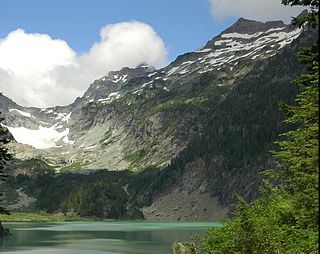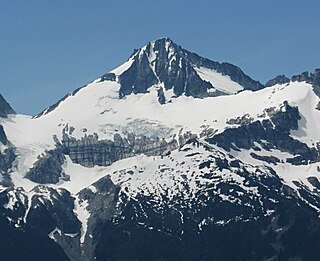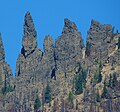
Kyes Peak, which is also known as "Goblin Peak", is a mountain peak located in the Henry M. Jackson Wilderness in Washington, United States. Kyes Peak rises to over 7,280 feet (2,220 m). Together with Columbia Peak and Monte Cristo Peak it forms a basin that contains Columbia Glacier and Blanca Lake. It is the highest summit in the Monte Cristo group of peaks.

Bonanza Peak is a tall peak in the North Cascades in the U.S. state of Washington and the Glacier Peak Wilderness of the Wenatchee National Forest. At 9,516 feet (2,900 m) in elevation, it is the highest point in Chelan County, and the highest non-volcanic peak in Washington and the Cascade Range as a whole. Bonanza Peak's prominence is 3,711 feet (1,131 m), making it the 26th most prominent peak in Washington. The nearest higher peak is Glacier Peak, 14.4 miles (23.2 km) to the southwest.

Buckner Mountain is a tall peak in the North Cascades of Washington state and in the Stephen Mather Wilderness of North Cascades National Park. At 9,114 feet (2,778 m) in elevation it is the highest in Skagit County and one of about ten of Washington's non-volcanic peaks above 9,000 feet high. It is ranked as the 14th highest peak in the state, and the third highest peak in North Cascades National Park.

Primus Peak is located in North Cascades National Park in the U.S. state of Washington. Primus Peak is flanked by North Klawatti Glacier to the south and Borealis Glacier to the northeast. Tricouni Peak is situated immediately east of Primus Peak.

Paul Bunyans Stump is a 7,480+ ft mountain summit in the North Cascades Range of Washington, United States. It is located within North Cascades National Park. It rises steeply from Diablo Lake, one of the reservoirs on the Skagit River. It is part of a group of peaks that form the northern end of a chain running south through climbing destinations such as Colonial Peak and Snowfield Peak. The nearest peak to Paul Bunyans Stump is Pinnacle Peak, 0.37 mi (0.60 km) to the north, and the nearest higher peak is Neve Peak, 0.9 mi (1.4 km) to the southeast. Like many North Cascade peaks, Paul Bunyans Stump is more notable for its large, steep rise above local terrain than for its absolute elevation. Precipitation runoff from the mountain drains into Diablo Lake and Skagit River.

The Triplets is a 7,240+ ft summit located in Skagit County of Washington state. This breccia triple pinnacle is part of the North Cascades Range. The Triplets is situated above Cascade Pass on the shared border of North Cascades National Park and Glacier Peak Wilderness. The nearest higher neighbor is Cascade Peak, 0.35 miles (0.56 km) to the west-northwest. Surface runoff from the mountain drains into the Cascade River.

Stiletto Peak is a 7,660 ft summit located in the Methow Mountains, a sub-range of the North Cascades in Washington state. It is situated in the Stephen Mather Wilderness on a ridge which also has Switchblade Peak and Jackknife Peak to its east. Stiletto Peak is also located on the boundary of North Cascades National Park, 2.24 miles (3.60 km) due north of Hock Mountain. Precipitation runoff on the north side of the mountain drains into Bridge Creek via Copper Creek, whereas the south side of the mountain drains into the East Fork Bridge Creek.

Prairie Mountain is a 5,678-foot-elevation mountain summit near the western edge of the North Cascades, in Snohomish County of Washington state. It is located six miles east of Darrington, Washington, and northwest of Glacier Peak which is one of the Cascade stratovolcanoes. It is situated on land administered by the Mount Baker-Snoqualmie National Forest. The nearest higher peak is White Chuck Mountain, 4.7 miles (7.6 km) to the south-southeast. Precipitation runoff from Prairie Mountain drains into the Sauk River and Suiattle River, both tributaries of the Skagit River. The mountain was so named because of the beautiful prairie at its base.

Sitting Bull Mountain is a 7,759-foot (2,365-metre) double summit mountain in the North Cascades of Washington state. The north summit is higher than the south peak, and easier to climb, however neither peak sees much climbing activity. Sitting Bull Mountain is located 2.1 mi (3.4 km) northwest of Suiattle Pass in the heart of the Glacier Peak Wilderness. Its nearest higher peak is Plummer Mountain, 1.51 mi (2.43 km) to the south-southwest. The mountain is situated on the crest of the Cascade Range, on the shared border of Snohomish County and Chelan County. Precipitation runoff from Sitting Bull Mountain drains east into Agnes Creek which is a tributary of the Stehekin River, or west into Canyon Creek which is a tributary of the Suiattle River.

Dumbell Mountain is an 8,421-foot (2,567-metre) double summit massif located in the Glacier Peak Wilderness of the North Cascades, in Chelan County of Washington state. The Dumbell summit is slightly higher than the northeast subpeak (8,415 ft) which is unofficially called Greenwood Mountain. Its nearest higher neighbor is Chiwawa Mountain, 2.4 mi (3.9 km) to the east-southeast. Precipitation runoff from Dumbell Mountain drains into tributaries of the Chelan River and the Wenatchee River. The mountain's descriptive name was applied by Albert Hale Sylvester (1871-1944), a pioneer surveyor, explorer, topographer, and forest supervisor in the Cascades.

The Chopping Block is a 6,819-foot (2,078-metre) mountain summit located in the Picket Range within North Cascades National Park in the state of Washington. The mountain is officially named Pinnacle Peak on maps, but hardly anyone calls it by that name. The nearest higher peak is Mount Degenhardt, 0.6 mi (0.97 km) to the northeast. The Chopping Block can be seen from the North Cascades National Park Newhalem visitor center, weather permitting. Precipitation runoff from the peak drains into Goodell Creek, a tributary of the Skagit River.

Cloudy Peak is a 7,915-foot (2,412-metre) mountain summit located in the Glacier Peak Wilderness of the North Cascades, in Chelan County of Washington state. Its nearest higher peak is North Star Mountain, 0.67 mi (1.08 km) to the northeast. Precipitation runoff from Cloudy Peak drains into Agnes Creek and Railroad Creek, both tributaries of the Chelan River.

Monument Peak is an 8,597-foot (2,620-metre) mountain summit located in western Okanogan County in Washington state. It is part of the Okanogan Range which is a sub-range of the North Cascades. The mountain is situated in the Pasayten Wilderness, on land administered by the Okanogan–Wenatchee National Forest. The nearest higher peak is Mount Lago, 2.42 miles (3.89 km) to the north. Precipitation runoff from Monument Peak drains east into Monument Creek, and west into Eureka Creek, which are both part of the Methow River drainage basin.

Remmel Mountain, also known as Mount Remmel, is a prominent 8,690-foot (2,650-metre) mountain summit located in Okanogan County in Washington state. It is the highest point in the Cathedral Range, which is a subrange of the Okanogan Range in the North Cascades. The mountain is situated 5 miles (8.0 km) south of the Canada–United States border, on the eastern side of the Cascade crest, in the Pasayten Wilderness, on land managed by the Okanogan–Wenatchee National Forest. The nearest higher peak is Mount Lago, 16.8 miles (27.0 km) to the west-southwest, and Amphitheater Mountain lies 3.6 miles (5.8 km) to the north. Remmel is the third-highest summit of the Okanogan Range following Mount Lago (8,745 ft), and Robinson Mountain (8,726 ft). These three peaks follow Jack Mountain {9,075 ft} as the highest peaks in the Pasayten Wilderness. Remmel is the most prominent mountain in the Pasayten Wilderness. Precipitation runoff from Remmel Mountain drains into the Chewuch River basin.

Pinnacle Peak is a 7,360+ ft mountain summit in the North Cascades Range of Washington, United States. It is located within North Cascades National Park, between Pyramid Peak and Paul Bunyans Stump, which is the nearest higher peak. It rises steeply from Diablo Lake, one of the reservoirs on the Skagit River. It is part of a group of peaks that form the northern end of a chain running south through climbing destinations such as Colonial Peak and Snowfield Peak. Like many North Cascade peaks, Pinnacle Peak is more notable for its large, steep rise above local terrain than for its absolute elevation. Precipitation runoff from the mountain drains into Diablo Lake and Skagit River. The approach is via the Pyramid Lake Trail, starting near Diablo Dam on the North Cascades Highway. From the lake, there is route-finding up Pyramid Arm to Colonial Glacier.

Bearcat Ridge is a 7,960+ ft mountain ridge located in the Chelan Mountains, in Chelan County of Washington state. It is situated on the boundary of Glacier Peak Wilderness, on land managed by Wenatchee National Forest. Its nearest higher peak is Emerald Peak, 1.1 mi (1.8 km) to the south-southwest, and Cardinal Peak is positioned 1.76 mi (2.83 km) to the south. Precipitation runoff from the ridge drains into nearby Lake Chelan via Emerald Creek and Bearcat Creek. Bearcat Ridge forms the high divide between these two creek valleys.

North Star Mountain is an 8,096-foot (2,468-metre) mountain summit located in the Glacier Peak Wilderness of the North Cascades, in Chelan County of Washington state. Its nearest neighbor is Cloudy Peak 0.9 mi (1.4 km) to the southwest, and the nearest higher neighbor is Bonanza Peak, 1.9 mi (3.1 km) to the northeast. North Star Mountain was originally named Bonanza Peak, and vice versa, but the USGS’ first 1904 topographic map of the region mistakenly interchanged the names. Precipitation runoff from North Star drains into Agnes Creek and Railroad Creek, both tributaries of the Chelan River.

Pinnacle Mountain is an 8,400+ ft granitic multi-peak massif located in the Chelan Mountains, in Chelan County of Washington state. The mountain is situated in Glacier Peak Wilderness of the North Cascades, on land managed by Wenatchee National Forest. Fred Beckey's Cascade Alpine Guide has the elevation of the highest pinnacle as 8,402 feet. Pinnacle Mountain ranks as the fourth-highest peak in the Chelan Mountains, and 75th-highest summit in Washington state. Its nearest higher neighbor is Saska Peak, 1.9 mi (3.1 km) to the southeast, and Emerald Peak is positioned 2.25 mi (3.62 km) to the east-southeast. Precipitation runoff from the peak drains into the Entiat River and Chelan River drainage basins.

Jumbo Peak is a 5,801 ft (1,770 m) volcanic mountain summit located in the Gifford Pinchot National Forest, in Skamania County of Washington state. It is situated in the Cascade Range, 15 mi (24 km) northwest of Mount Adams, 20 mi (32 km) east-northeast of Mount St. Helens, and 38 mi (61 km) south of Mount Rainier. Its nearest higher neighbor is Sunrise Peak, 1.7 mi (2.7 km) to the north-northeast. Precipitation runoff from Jumbo Peak drains into tributaries of the Cowlitz River drainage basin. The Juniper Ridge Trail (#261) which skirts this peak provides access to this remote peak.

Coldwater Peak is a 5,722 ft (1,740 m) mountain summit located in Mount St. Helens National Volcanic Monument, in the Gifford Pinchot National Forest, in Skamania County of southwest Washington state. It is situated in the Cascade Range, 2 mi (3.2 km) northwest of Spirit Lake, and 2 mi (3.2 km) east of Coldwater Lake. Its nearest higher neighbor is Mount Margaret, 2.4 mi (3.9 km) to the northeast, and Mount St. Helens rises 7 mi (11 km) to the south. Precipitation runoff from Coldwater Peak drains into Coldwater Creek, a tributary of the North Fork Toutle River. The mountain takes its name from this creek, and was officially adopted in 1983 by the U.S. Board on Geographic Names. A trail provides access to the summit, the site of the former Coldwater Lookout from 1935 to 1968, and now is a site for research instruments.



























